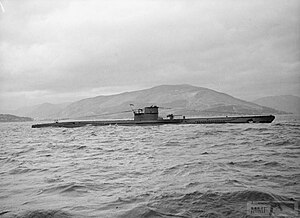German submarine U-925 was a Type VIIC U-boat of Nazi Germany's Kriegsmarine during World War II.
 U-570 Type VIIC submarine that was captured by the British in 1941. This U-boat is almost identical to U-925.
| |
| History | |
|---|---|
| Name | U-925 |
| Ordered | 25 August 1941 |
| Builder | Neptun Werft AG, Rostock |
| Yard number | 512 |
| Laid down | 15 June 1942 |
| Launched | 6 November 1943 |
| Commissioned | 30 December 1943 |
| Fate | Missing since 25 August 1944 |
| General characteristics | |
| Class and type | Type VIIC submarine |
| Displacement | |
| Length |
|
| Beam |
|
| Height | 9.60 m (31 ft 6 in) |
| Draught | 4.74 m (15 ft 7 in) |
| Installed power |
|
| Propulsion |
|
| Speed |
|
| Range | |
| Test depth |
|
| Complement | 4 officers, 44–52 enlisted |
| Armament |
|
| Service record | |
| Part of: |
|
| Identification codes: | M 43 854 |
| Commanders: | |
| Operations: |
|
| Victories: | None |
She was ordered on 25 August 1941, and was laid down on 15 June 1942 at Neptun Werft AG, Rostock, as yard number 512. She was launched on 6 November 1943 and commissioned under the command of Oberleutnant zur See Hellmut Knoke on 30 December 1943.[2]
Design
editGerman Type VIIC submarines were preceded by the shorter Type VIIB submarines. U-925 had a displacement of 769 tonnes (757 long tons) when at the surface and 871 tonnes (857 long tons) while submerged.[3] She had a total length of 67.10 m (220 ft 2 in), a pressure hull length of 50.50 m (165 ft 8 in), a beam of 6.20 m (20 ft 4 in), a height of 9.60 m (31 ft 6 in), and a draught of 4.74 m (15 ft 7 in). The submarine was powered by two Germaniawerft F46 four-stroke, six-cylinder supercharged diesel engines producing a total of 2,800 to 3,200 metric horsepower (2,060 to 2,350 kW; 2,760 to 3,160 shp) for use while surfaced, two SSW GU 343/38-8 double-acting electric motors producing a total of 750 metric horsepower (550 kW; 740 shp) for use while submerged. She had two shafts and two 1.23 m (4 ft) propellers. The boat was capable of operating at depths of up to 230 metres (750 ft).[3]
The submarine had a maximum surface speed of 17.7 knots (32.8 km/h; 20.4 mph) and a maximum submerged speed of 7.6 knots (14.1 km/h; 8.7 mph).[3] When submerged, the boat could operate for 80 nautical miles (150 km; 92 mi) at 4 knots (7.4 km/h; 4.6 mph); when surfaced, she could travel 8,500 nautical miles (15,700 km; 9,800 mi) at 10 knots (19 km/h; 12 mph). U-925 was fitted with five 53.3 cm (21 in) torpedo tubes (four fitted at the bow and one at the stern), fourteen torpedoes or 26 TMA mines, one 8.8 cm (3.46 in) SK C/35 naval gun, (220 rounds), one 3.7 cm (1.5 in) Flak M42 and two twin 2 cm (0.79 in) C/30 anti-aircraft guns. The boat had a complement of between 44 — 52 men.[3]
Service history
editOn 24 August 1944, U-925 left Kristiansand on her first war patrol, sailing through the Iceland passage en route to the North Atlantic for weather reporting duty. Nothing was ever heard again from U-925 and she was posted missing on 18 September 1944, all hands, 51 crewmen, lost.[2]
References
edit- ^ Helgason, Guðmundur. "Hellmut Knoke". German U-boats of WWII - uboat.net. Retrieved 5 April 2016.
- ^ a b Helgason, Guðmundur. "U-925". German U-boats of WWII - uboat.net. Retrieved 5 April 2016.
- ^ a b c d Gröner 1991, pp. 43–46.
Bibliography
edit- Busch, Rainer; Röll, Hans-Joachim (1999). German U-boat commanders of World War II : a biographical dictionary. Translated by Brooks, Geoffrey. London, Annapolis, Md: Greenhill Books, Naval Institute Press. ISBN 1-55750-186-6.
- Busch, Rainer; Röll, Hans-Joachim (1999). Der U-Boot-Krieg, 1939-1945: Deutsche U-Boot-Verluste von September 1939 bis Mai 1945 [German U-boat losses from September 1939 to May 1945] (in German). Vol. IV. Hamburg, Berlin, Bonn: Mittler. ISBN 3-8132-0514-2.
- Gröner, Eric; Jung, Dieter; Maass, Martin (1991). German Warships 1815-1945: U-boats and Mine Warfare Vessels. Vol. 2. Translated by Thomas, Keith; Magowan, Rachel. London: Conway Maritime Press. ISBN 0-85177-593-4.
External links
edit- Helgason, Guðmundur. "Patrols by U-925". German U-boats of WWII - uboat.net.
- Roll of Remembrance